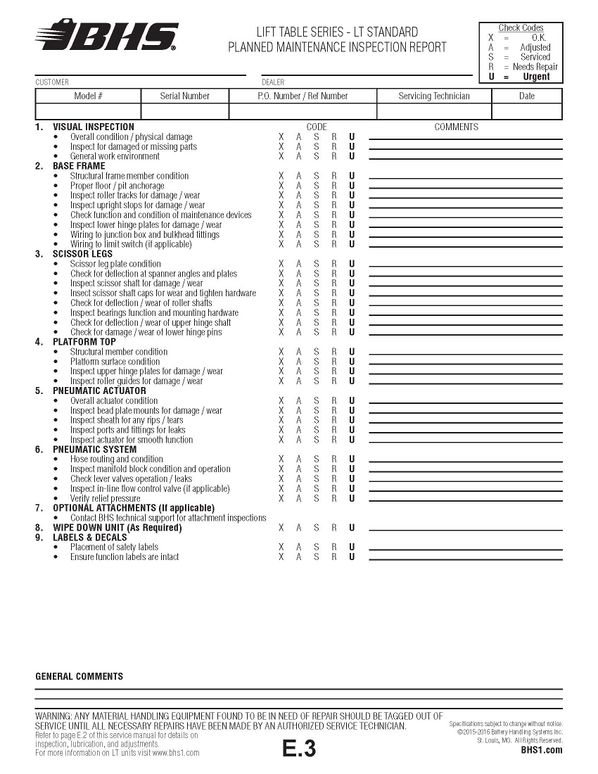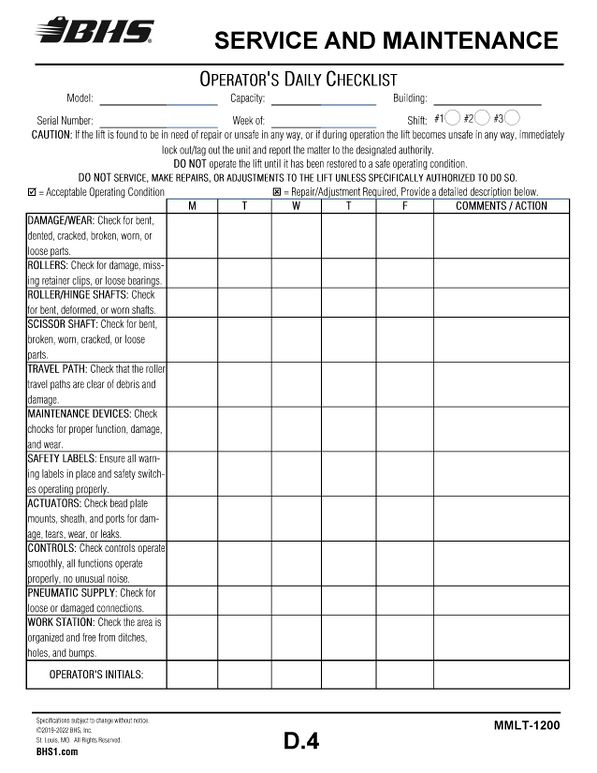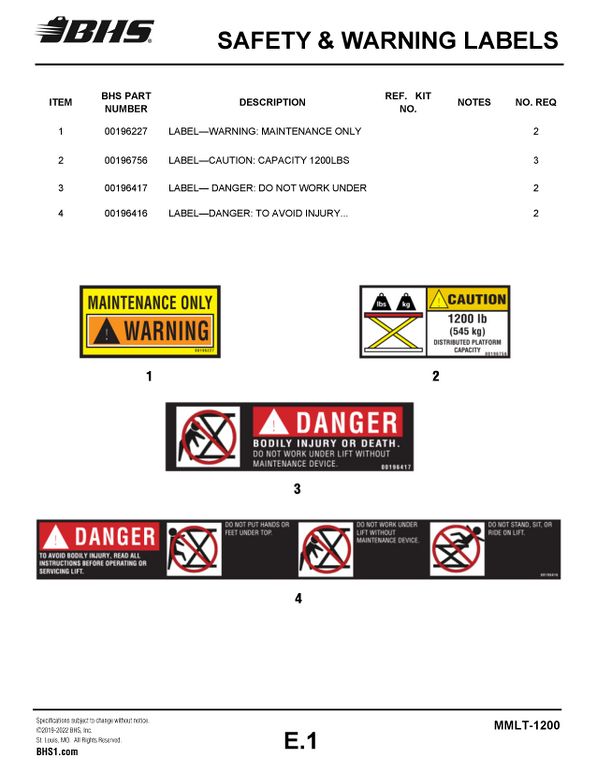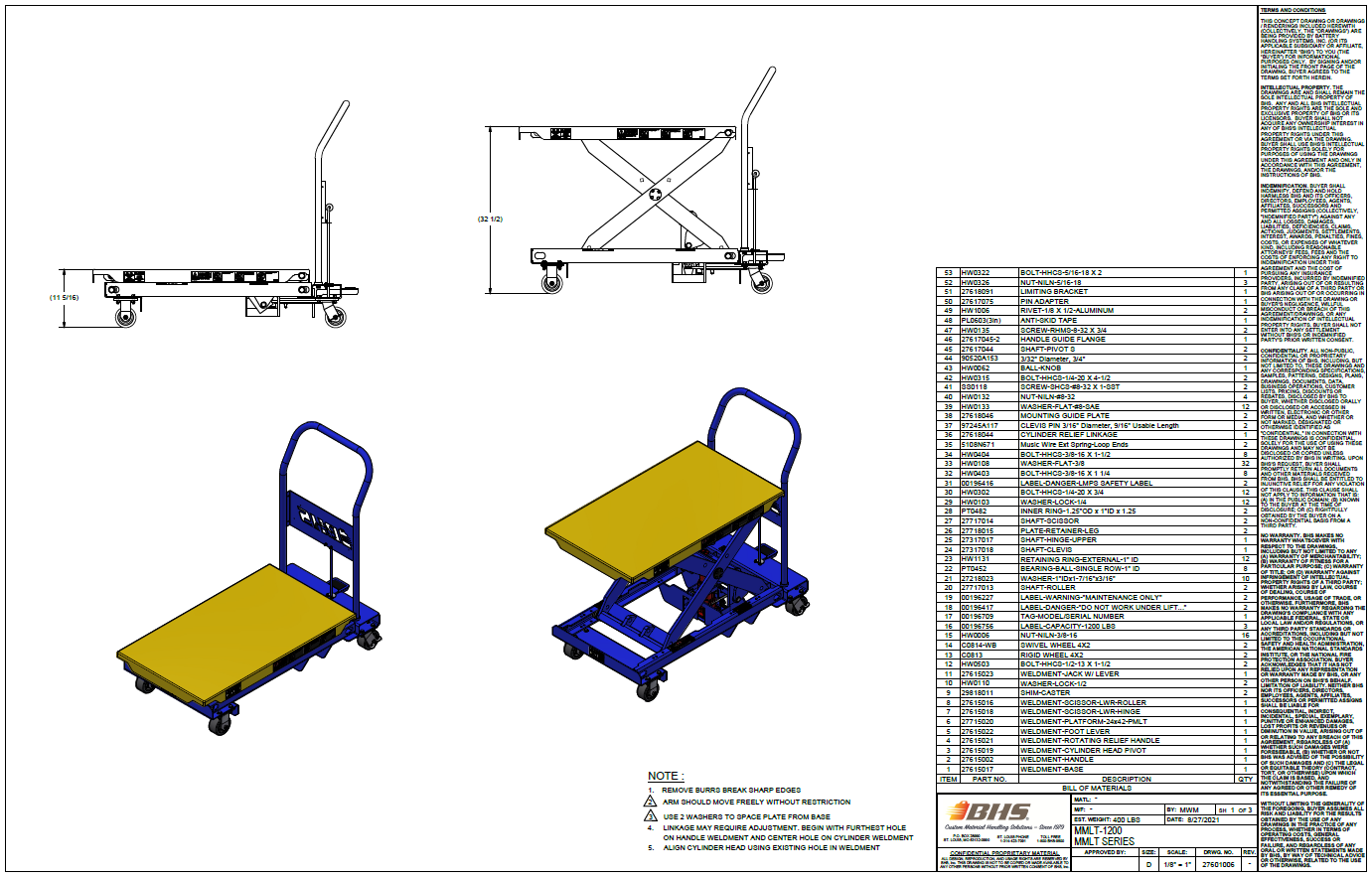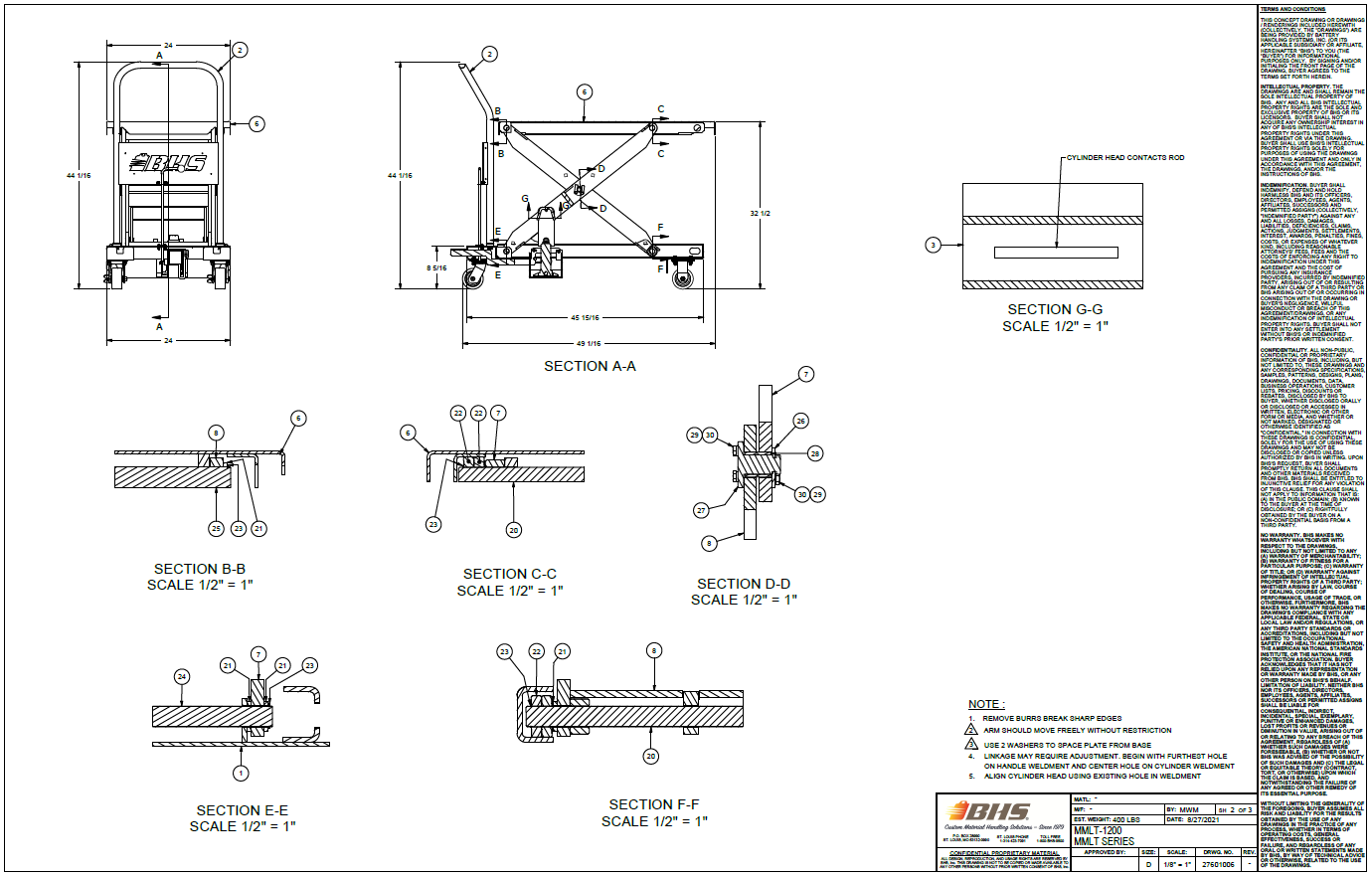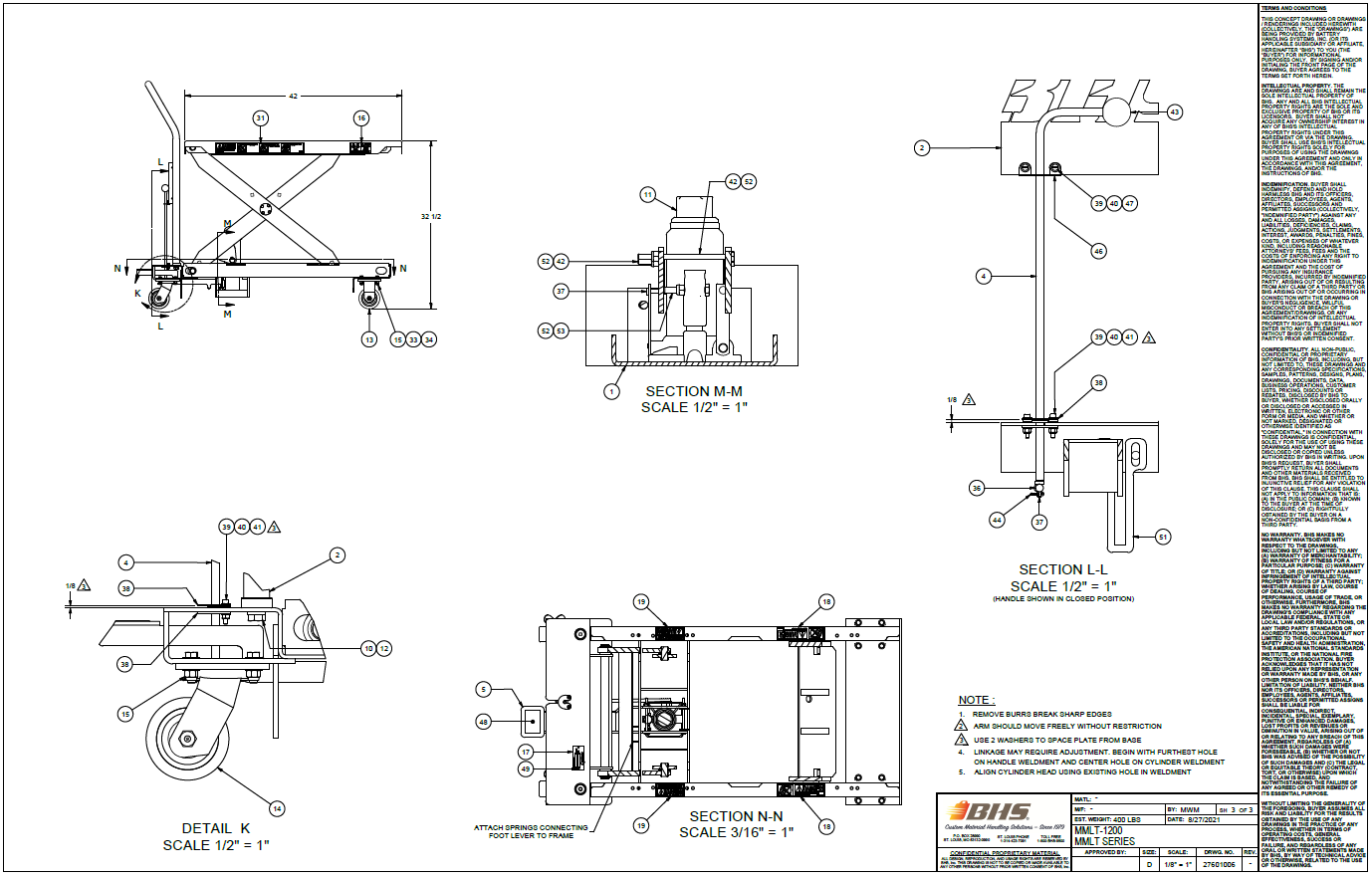IOP-276 MMLT
Looking for a specific replacement part? Ctrl-F (or Command-F for Mac users) brings up your browsers search panel and can search any text on the entire web page. Find parts by searching a part # or part description.
Register your equipment with BHS Optima, BHS's free app.
California Residents: WARNING: This product contains chemicals known to the State of California to cause cancer and/or reproductive harm, and birth defects or other reproductive harm. Learn more here.
Manual Mobile Lift Table (MMLT) Parts & Services Manual
GENERAL INFORMATION
Read and understand this manual before installation, use, and maintenance for your lift. Please be sure that no individual is allowed to use this lift unless they have been fully trained and familiarized with the operating instructions of this manual. Also, ensure that at least one person on site is familiar with the maintenance section of this manual and is responsible for performing the defined tasks. If you have any questions regarding operation, service, or the contents of this manual, please contact your dealer or BHS Technical Support 1.877.BHS.4YOU (1.877.247.4968) or visit tech.bhs1.com.
Lift Tables (LT Series) position materials at comfortable heights for improved ergonomics and productivity. The LT Series is designed to reduce physical strain, fatigue, and prevent injury by eliminating heavy lifting, bending, and reaching. Lift Tables are available in many standard sizes and capacities to position loads. Please consult a dealer or sales representative for application specific needs.
GENERAL SAFETY
- Read and understand all instructions and warnings (as applicable) before using or servicing this equipment
- Keep these instructions for future reference.
- Unit(s) shall only be used indoors in an industrial setting on a hard, nonslip, and level floor without irregularities including but not limited to holes, gouges, cracks, drains or obstacle comprised of concrete or other suitable industrial material.
- Forces required to operate the LT unit will vary with weight of the load, floor conditions, and unit conditions.
- Stationary LT units are designed to only be operated when securely mounted to the floor using approved hardware.
- A licensed structural engineer should be consulted prior to installing an LT unit on any building level other than the ground floor.
- Perform system and safety checks before operating.
- Failure to follow these instructions and warnings may result in property damage, personal injury or death.
WORK AREA
- Keep work area clean and well lit. Cluttered work areas and poor lighting can lead to accidents.
- Clean-up/contain any fluid spills immediately to prevent slips or falls.
- Be aware of potential hazards when performing any service or maintenance to the unit.
SERVICE & MAINTENANCE
Service personnel shall wear Personal Protective Equipment (PPE) appropriate for the task being performed. Deploy maintenance chocks before performing any repairs or maintenance on the unit.
LOCKOUT/TAGOUT
Lockout/tagout the unit if damaged or not functioning properly. Lockout/tagout and de-energize all systems prior to performing any maintenance or service to unit(s).
HYDRAULIC HAZARDS
AVOID HIGH PRESSURE FLUIDS - Escaping fluid under pressure can penetrate the skin causing serious injury. Relieve pressure before disconnecting hydraulic lines. Tighten all connections before applying pressure. Keep hands and body away from pin holes which eject fluids under high pressure. Use a piece of cardboard or paper to search for leaks. DO NOT use your hand.
Any fluid injected into the skin under high pressure should be considered a serious medical emergency despite an initial normal appearance of the skin. There will be a delayed onset of pain, and serious tissue damage may occur. Medical attention should be sought immediately.
INSTALLATION
INSTALLATION NOTES
MOBILE TABLE, NO INSTALLATION REQUIRED
Prior to application of the lift, unpack and remove all shipping materials. A visual inspection should be conducted to check for missing parts or damage occurred during transit.
OPERATION
The following instructions will guide you through the basic steps necessary to properly and safely operate this lift. Before using this lift, the operator should:
- Read and understand this manual and the operating instructions.
- Be thoroughly trained on the use and safety of this lift.
- Inspect for proper operating conditions and safety devices.
- Check for and eliminate any obstructions in the travel path.
KEEP HANDS, ARMS, FEET, LEGS, HAIR, AND JEWELRY OUT OF THE TRAVEL PATH WHILE THE UNIT IS IN OPERATION.
LOADING THE PLATFORM
The load capacity rating is stated on capacity labels throughout the unit. The capacity rating is the maximum load for a standard lift model with a standard platform top. Modifications and additions to this lift shall not be made without prior written consent from the manufacturer. Where special tops, attachments, etc. are installed on the lift after shipment, deduct the weight of these from the load capacity rating to obtain the new maximum capacity.
- NEVER EXCEED THE LOAD CAPACITY RATING. Overloading the lift will result in severe personal injury or death, cause structural damage to the lift, shorten the life of the lift, and void the unit’s warranty.
- NEVER OFFSET THE LOAD. Do not overhang a load on either end of the platform. This could cause the platform to fail, thus dropping the load and causing severe personal injury or death.
- ALWAYS BALANCE & CENTER THE LOAD. Balanced and centered loads will promote the longest life of the unit and ensure even wear on all moving parts.
- ALWAYS SECURE THE LOAD. A balanced and secure load is the safest means of lifting the load.
CONTROLS
- Raise the table top by pumping the foot pedal while the relief handle is in the right position.
- Lower the platform by slowly rotating the relief handle to the left.
- Carefully place the load on the table top, ensuring that weight is evenly distributed.
ALWAYS transport the load to and from the table top using an approved and certified method.
When moving table while loaded, ensure that the load is STABLE and PROPERLY SECURED.
ONLY MANUFACTURER PROVIDED PARTS ARE APPROVED FOR USE WITH THIS LIFT TABLE. All modifications must be approved by lift manufacturer prior to use.
- Carefully watch the unit as it raises to ensure proper function of all components.
- Lockout/Tagout the unit and immediately notify the supervisor or maintenance personnel if the unit is found to be operating abnormally.
OPERATIONAL SAFETY
OPERATIONAL SAFETY
- Only personnel trained in the proper and safe operation of LT units may operate or service the lift table.
- All data plates, warning labels, placards, etc. shall be in place and legible at all times. Contact BHS for replacement data plates, warning labels, placards or instructions.
- All users and service personnel shall be familiar with the meaning, significance, and risks associated with all data plates, warning labels, etc.
- All operators and service personnel shall be aware of potential crush and shear points while operating or servicing the LT unit.
- LT units shall be operated in an area with ambient light levels of at least 50 lux.
- Keep hands, arms, feet, legs, hair, clothing and jewelry outside and away from the perimeter of the machine or travel path while operating the LT unit.
- Avoid abrupt motions when operating a LT unit to prevent loss of the load and/or loss of control of the LT unit.
- Remove the LT unit from service if damaged or operating improperly (or becomes such while operating) until repairs can be made to correct any problem(s).
DO'S AND DONT'S
- DO NOT exceed the maximum capacity of the LT unit.
- DO NOT modify or fit the LT unit with attachments without prior, written approval from BHS.
- DO NOT perform any maintenance or service to the LT unit with a load on the platform.
- DO NOT allow anyone to ride in or climb on the LT unit.
- Disconnect the LT unit from all power sources before attempting to perform service or maintenance to the unit.
- For stationary models only: Mount the LT unit to the floor using approved concrete anchors or bolts prior to lifting any load.
- DO NOT service the LT unit without proper personal protective equipment (PPE) or without taking appropriate safety measures.
- DO NOT use the LT unit in a manner for which it is not intended. Some examples of prohibited use are but not limited to:
- As a personnel lift
- As a vehicle jack
- To lift loads greater than its rated load capacity
- Where unintentional movement may occur
- Having direct contact with foodstuffs
- In a potentially explosive atmosphere
- On an uneven floor or surface
- Without being properly anchored to the floor (Note: Stationary Models only)
SERVICE AND MAINTENANCE
The following are the basic practices necessary to properly, and safely, service and maintain this unit. It is recommended that a routine maintenance program be enforced to prolong the life of the unit and prevent costly repairs or downtime. Before servicing this unit, the operator should:
- Read and understand “SERVICE AND MAINTINANCE” instructions.
- Read and understand this manual and the service and maintenance instructions.
- Understand mechanical devices and their associated hydraulics.
- Be thoroughly trained on the use and safety of this unit.
SAFE SERVICE PRACTICES
Failure to follow proper safety procedures can result in serious personal injury or death.
- Inspect the lift in regular intervals: daily, weekly, monthly, and yearly. See pages D.2, D.3, D.4 of this manual.
- DO NOT ignore a unit in need of repair. A unit in disrepair can be a severe hazard to persons and/or property when left unattended.
- Use only BHS approved replacement parts.
- Observe and identify all potential hazards prior to servicing the unit.
NEVER attempt to hold the table top up by lifting the platform top.
- This can damage hydraulic components, structural members, and could lead to serious injury or death.
Tilting the platform over center can cause damage to the unit
NEVER WORK UNDER THE LIFT WITHOUT TABLE TOP FULLY LOWERED OR FULLY RESTRAINED. Failure to follow this safety practice will result in serious personal injury or death.
- NEVER leave the table top loaded while performing maintenance
- Ensure the table top is fully lowered prior to performing service to the unit unless necessary for required repairs.
- Disconnect power supply (if applicable) prior to servicing or maintenance.
- Always lockout/tagout unit during maintenance/service.
Failure to disconnect electrical power to the LT unit could result in electrical shock. Serious personal injury or death will occur.
LUBRICATION
| # OF PLACES | INTERVALS | |
|---|---|---|
| Lubricate grease fittings using #2 lithium based grease. | ||
| A. Lower Cylinder Pivot Shafts | 2 places | Monthly |
| Complete Preventative Maintenance (PM) | - | Quarterly |
These recommendations are based on average use in a typical warehouse environment and may need adjustment based on individual circumstances. Dusty and/or extreme hot/cold environments may require more frequent lubrication.
· DO NOT clean this unit with a high pressure wash.
· Wipe the unit down with a clean, dry cloth when cleaning is required.
PLANNED MAINTENANCE INSPECTION REPORT
OPERATOR'S DAILY CHECKLIST
SAFETY & WARNING LABELS
PARTS
CHASSIS
STATEMENT OF WARRANTY
Statement of Warranty
Click here for details on BHS' Statement of Warranty.

